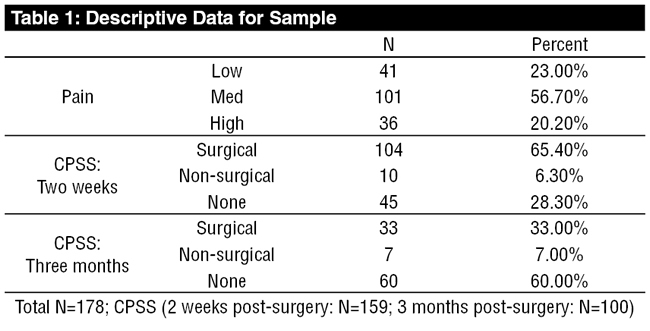Long Term Psychological Outcomes Following Nuss Procedure
By Kristen Uhl, PhD1, Wallis T. Muhly, MD2, Henry Huang, MD3, Robert Wilder, MD, PhD4, Joseph Cravero, MD1
1Boston Children's Hospital, Harvard Medical School, Boston, MA
2The Children’s Hospital of Philadelphia, Perelman School of Medicine of the University of Pennsylvania
3Texas Children’s Hospital, Baylor College of Medicine
4Mayo Clinic College of Medicine and Science
(Summarized and submitted by Kristen Uhl, PhD)
Nuss procedures are a commonly performed surgical correction for pectus excavatum. While termed “minimally invasive”, these procedures are associated with significant postoperative pain.1 Little is currently known about how surgery and hospitalization for this procedure impact long-term functioning post-discharge.2 The Society of Pediatric Anesthesia Improvement Network conducted a detailed, multi-site observational study to examine outcomes in pediatric patients undergoing Nuss procedure.
This research group gathered preoperative, intraoperative, and immediate post-operative outcome data along with information on post-operative psychological functioning at two weeks and three months post-hospitalization. Analyses of the short-term perioperative outcomes from this cohort were recently published. However, interest remained in how the immediate perioperative pain experience might impact post-traumatic psychological symptoms for both the immediate and longer-term. Pediatric patients undergoing pectus excavatum repair surgeries were prospectively enrolled at 14 participating institutions. For the purposes of this analysis, 178 patients ages 8-17 who completed the Child PTSD Symptom Scale (CPSS) at two weeks or three months were included.3 Qualitative responses to the CPSS were grouped into three categories: surgical trauma (distress related to aspects of the procedure, hospitalization, or post-discharge complications), non-surgical trauma (distress related to a non-surgical stimulus), and no trauma (denial of current distress).
Pain during hospitalization was categorized into low (0-3), medium (4-6), and high (7-10) groups based on highest daily median pain score for each individual patient. Our findings indicated that a number of adolescents undergoing Nuss procedures experience psychological trauma symptoms at two weeks and three months following the procedure (Table 1). Surgical trauma symptoms at both time points were associated with higher pain scores in the perioperative period (p<.05). Further research is needed to determine how pre-existing psychological factors may impact both the perioperative experience and longer term outcomes for this procedure. Findings may enable providers to mitigate long term psychological distress by improving pain control in the perioperative period.

Recognition:
This data was collected as part of the Society for Pediatric Anesthesia Improvement Network Project on the Nuss Procedure.
References:
- Frawley, G., Frawley, J., & Crameri, J. (2016). A review of anesthetic techniques and outcomes following minimally invasive repair of pectus excavatum (Nuss procedure). Pediatric Anesthesia, 26(11), 1082-1090.
- Muhly, W.T., Maxwell, L.G. and Cravero, J.P., 2014. Pain management following the N uss procedure: a survey of practice and review. Acta Anaesthesiologica Scandinavica, 58(9), pp.1134-1139.
- Foa, E. B., Cashman, L., Jaycox, L., & Perry, K. (1997). The validation of a self-report measure of posttraumatic stress disorder: The Posttraumatic Diagnostic Scale. Psychological assessment, 9(4), 445-451.


